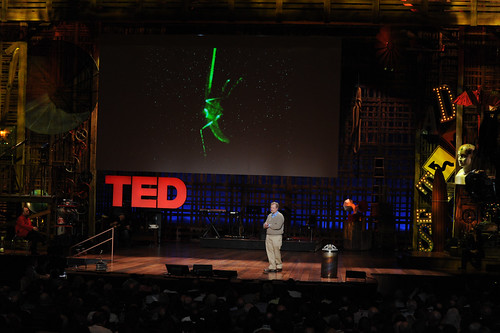David Byrne

 Score: 5 balloons
Score: 5 balloonsDavid Byrne of Talking Heads fame gave an interesting talk about the impact of spaces on music -- how the elements of different musical genres can be traced back to the spaces in which that music was performed, or the technical capabilities of the delivery mechanism (e.g. radio, CD, car boom box, iPod). He draws examples from Baroque, Jazz, Choral and other styles, explaining they differ in their allowance of volume changes, key changes, held notes, musical detail and other stylistic effects based on the acoustics of the cathedral, palace room, smokey bar or other venue. Of course he also shared photos of his grungy basement, where he and his buddies first wrote and performed.
Nathan Mhyrvold
 Score: 8 balloons
Score: 8 balloonsTo combat his reputation as patent troll, the former Microsoft CTO talked about his company's facility for invention, such as an optical scanner that can detect malaria by illuminatng hemozoin (waste from the malaria parasite), or a container that can dispense vaccines but keep the remaining ones cool inside -- without power -- for up to 6 months. But he brought his team's most awesome invention to demonstrate on stage; although it may not be the most practical intervention for African malaria, it is surely the coolest: a laser defense system from mosquitoes!

Mhyrvold's machine, which we got to examine up close later in the lobby, was made purely of parts bought on eBay. At one of the stage he placed a fish tank with mosquitoes flying around. At the other end, a good 20 yards away, he placed his gizmo that tracks the mosquitoes through long range infra-red cameras, extrapolates their motion in a computer, and then illuminates them each, as they fly, with frickin' laser beams! To keep the demo going they used low energy levels so as not to burn the critters, though of course that's what the machine is built to do (and Nathan brought videos of the buggers smoking up just to prove it works). Even better, they use two different color lasers to distinguish the genders, so they could choose to kill only the infectious females! (I'm guessing no one would mind if they killed all the mosquitoes, but someone thought up a way to hear the difference and it was too cool a feature not to include.)
Legion of Extraordinary Dancers
I don't normally blog the entertainment, but the LXD are superheroes. Check them out...
I don't normally blog the entertainment, but the LXD are superheroes. Check them out...
Mark Roth
 Score: 8 balloons
Score: 8 balloonsCancer researcher Mark Roth presented another candidate for the It-May-Not-Be-Pratical-But-It's-Cool-As-Shit Award. He and his team studies "metabolic flexibility", the phenomenon observed in rare medical cases where people are dead for hours -- usually in frozen conditions -- and then revived when their bodies are warmed. They hypothesized that our bodies may have some agent that can somehow lower our metabolism to the point where, under distress, we can do without oxygen for hours.

The concept of inducing suspended animation is not pure science fiction. Human eggs survive up to 50 years inside ovaries, and plant spores can survive up to 250 million years. The number of cases where human beings returned from frozen death states with no heartbeat has inspired the saying, "You're not dead until you're warm and dead."
Some of those cases involved industrial accidents in which workers collapsed after exposure to hydrogen sulfide, and were thought to be dead for hours until they were removed from the poisoned air and "woke up". Roth realized that we have trace amounts of hydrogen sulfide in our brains, and so perhaps this is the mystery agent. Early tests on rodents support the hypothesis, successfully "killing" the specimens until they are removed from the hydrogen sulfide chambers. So Roth's team is now in clinical trials with a drug that would place trauma victims in suspended animation for hours until their wounds can be properly treated. Really.
Seth Berkley
 Score: 6 balloons
Score: 6 balloonsAIDS Researcher Seth Berkley presented some startling statistics on flu pandemics, suggesting that we are likely to soon see another like the one in 1918 that killed 100 million people.
Berkley also presented some promising research on a new vaccine to fight AIDS. He presented a great animation developed by XVIVO to illustrate the mechanism by which the memory cells that develop from vaccines can fight the AIDS infection.
Stephen Wolfram
 Score: 8 balloons
Score: 8 balloonsWith Wolfram's characteristic ego, he launched his talk about "the biggest idea of the century" which is, if I understood him, computational complexity. Wolfram has made his career studying emergent complexity, as documented in his humbly titled volume A New Kind of Science.
At TED he presented three things: an impressive demonstration of Wolfram Alpha, his web-based front-end to a computational engine; some background on mathematica, his attempt to build a structured, comprehensive computational engine; and his simulation of physical models designed to suss out those that reflect reality (I think he's basically trying to find the grand unification theory of physics through trial and error).
Mathematica is sure impressive. But the computational science community won't be moved by solely by the wysiwyg interface. Remember it's the same community that prefer LaTeX to MS word. I would say the next game changing feature in the industry is not visualization, but gpu computing.
ReplyDelete